Milan and Atalanta met in Serie A this weekend with both sides safe in the knowledge that their respective European competition places are now secure. This tactical analysis will look at the tactics both teams used in their attempt to pick up the three points and continue the good form that both teams have shown since the resumption.
Milan is one of the form teams in Serie A right now after wins over Lazio and Juventus in previous matchdays and a last game win over the attacking Sassuolo with some fluid attacking football and the return of Zlatan Ibrahimović netting them seven goals against the top two. Meanwhile, Gian Piero Gasperini’s Atalanta side have picked up twenty-seven points since the restart with notable wins over Napoli, Lazio, and Sassuolo and a point against Juventus who needed two Ronaldo penalties to rescue the draw.
Game context
With Milan as one of the form sides in Serie A right now, Atalanta would rightly have expected a difficult encounter. Pioli’s men have collected twenty-three points since the restart and there is a growing belief amongst their group that they are ready to compete at the top table of Italian football once again. For Atalanta, they have had no shortage of entertainment and goals during their games so far this season. Averaging 2.4 goals per game according to the xG is one thing in itself, but reality places them higher at 2.6 goals per game. Their dynamic attacking play and ability to rest and rotate players while still making an attacking imprint on the game underpins their current third position in Serie A.
In the last encounter just before Christmas, Atalanta destroyed Milan 5-0 in the early stages of Pioli’s reign. The usual Atalanta suspects in front of the goal did the damage that day with Luis Muriel, Josip Illicic, and Alejandro Gomez all scoring. For Atalanta, this scoreline is not an outlier with Gasperini’s side scoring five or more on six separate occasions so far this season.
Team News
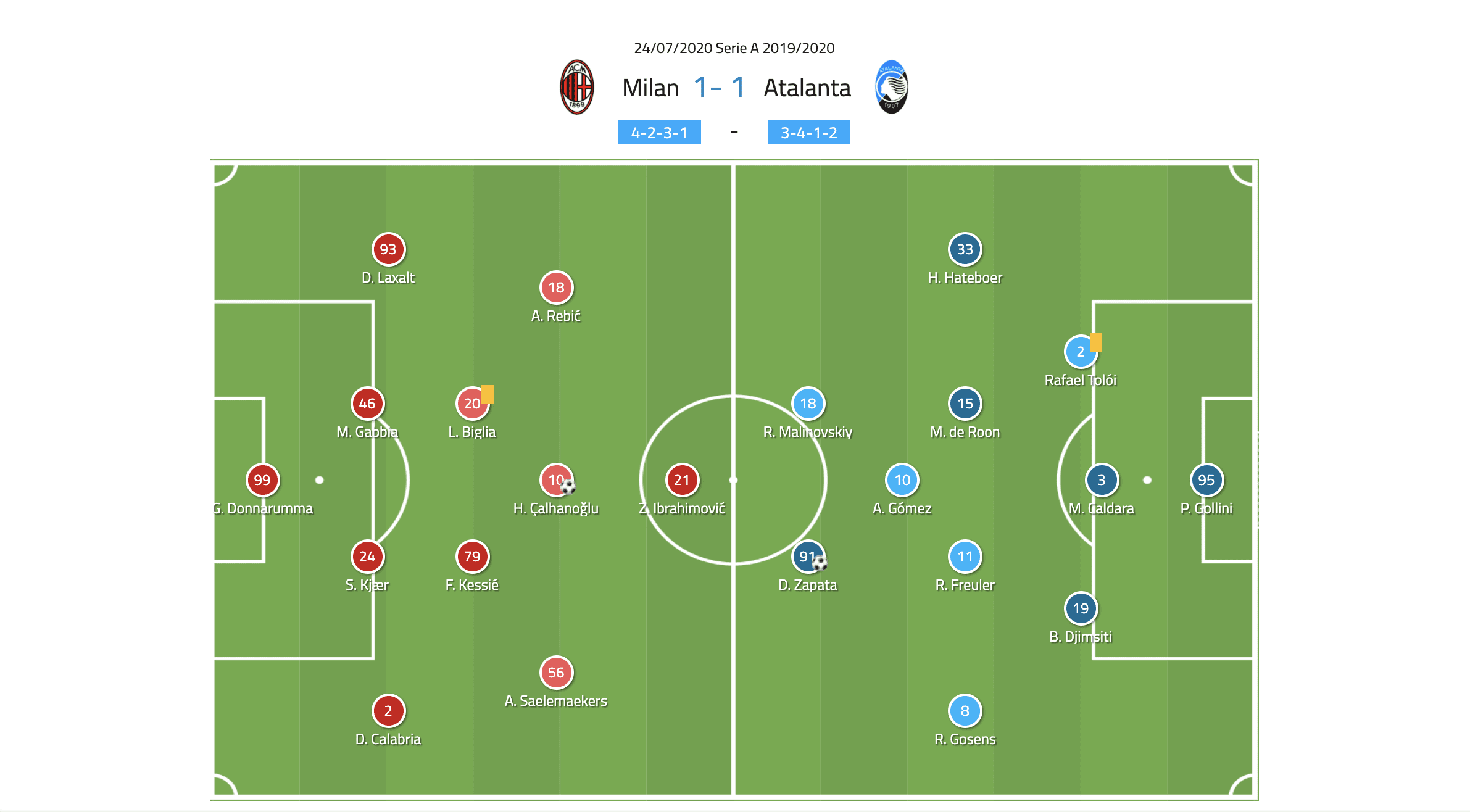
For Milan, Ibrahimović continued as the focal point in the top line in their 4-2-3-1. It is, without doubt, the best way to accommodate him in this side at present and he has been a real catalyst for the Milan resurgence since the restart. Pioli battled some heavy unavailability in this game though with only Simon Kjaer and Gigi Donnarumma continuing from last time out in the win over Sassuolo in the backline. Hakan Çalhanoğlu continued in the side underneath Ibrahimović while the only change in front of the back four came with Lucas Biglia coming in to play alongside Franck Kessie at the base of midfield.
Gasperini’s usual 3-4-3 shape contained one change in the back three with Mattia Caldara coming into the central position. Hans Hatebor came into the side on the right-hand side of midfield and Mario Pasalic was replaced by Ruslan Malinovskyi in the top line.
Game Overview
Milan started brightly and as we will see, caused Atalanta some trouble. They took the lead in the 14th minute through a high-quality free-kick from Çalhanoğlu who bent a cross come shot over Gollini in the Atalanta goal and into the far corner. The goalkeeper will have been disappointed not to have done better. Gollini did better a little later when he turned an angled Rebic shot past the post. When Biglia was booked for a reckless stamp on Malinovskyi while the Ukrainian was untangling himself from the ball at the top of the box in the 20th minute, he gifted Atalanta a chance to level the game. Donnarumma guessed correctly and blocked the Malinovskyi spot-kick.
Duvan Zapata did equalise in the 34th minute when he finished off a scrappy counter-attacking move that had two blocked shots, the second which fell at his feet for him to put away under Donnarumma. The second half brought Atalanta two good chances after good work from substitute Lucas Muriel on the right flank, they gave opportunities to Gomez, who flashed a half volley just wide of the near post and Zapata who had a good chance blocked.
Milan had a shot from outside the box from substitute Giacomo Bonaventura hit a post from a counter-attack late on which rounded out the second half action as both teams settled for a point.
Tactical Overview
With Gasperini’s 3-4-3 looking more like a front two of Duvan Zapata and Malinovskyi with Gomez in behind them, they used their wing-backs to stretch and pin the Milan back four. This tactical analysis will look at Atalanta’s use of de Roon in the build-up to create problems for Milan in wide areas and free up space in central positions for Gomez to thrive. This tactical analysis will also look at Milan’s front four and their occupation of Atalanta’s backline to create a platform to attack and how this platform was built on some clever tactical tweaks to bring Atlanta narrow. This is where this analysis begins.
Milan’s Build up to create attacks
Milan’s use of their full-backs is always fundamental to the way Pioli likes his team to build from the back, even against high pressing, energetic teams like Atalanta. Milan will use raiders like Teo Hernandez and Conti to create width higher up the pitch against teams with a back four, but for teams like Atalanta employing a back three, Pioli will often mix things up to encourage the opponent wing-back from his line. Here against Atalanta, he decided to use his two holding midfield players, Biglia and the impressive Kessie to narrow Milan into the centre of the pitch to free up passes into wide areas.
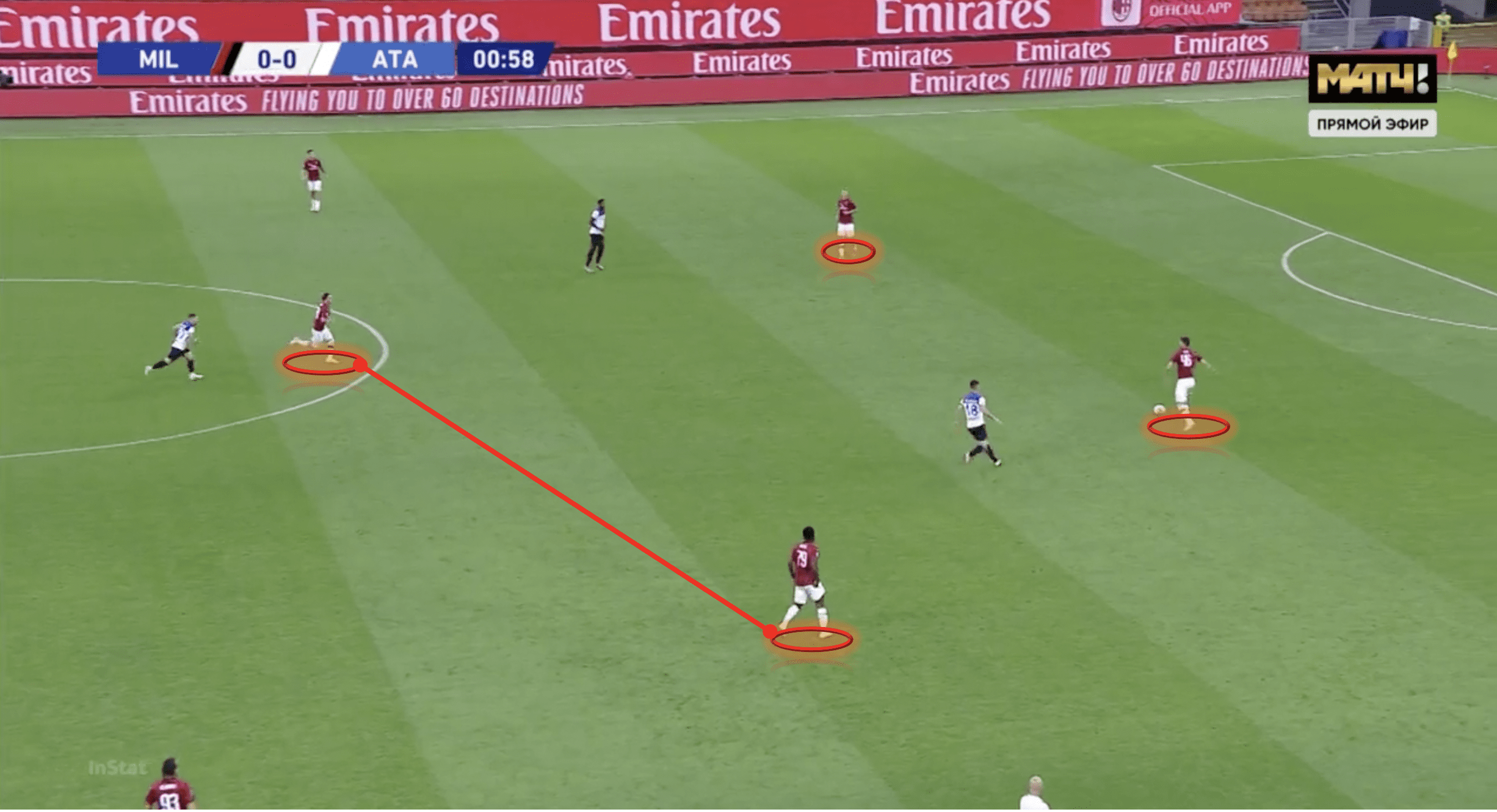
Here in this image, even early in the game, you can see the plan taking shape. Malinovskyi and Zapata occupy the Milan centre-backs however Biglia and Kessie outnumber Gomez. Without releasing another midfield player, the pass into Biglia allows him to free Kessie in time and space.
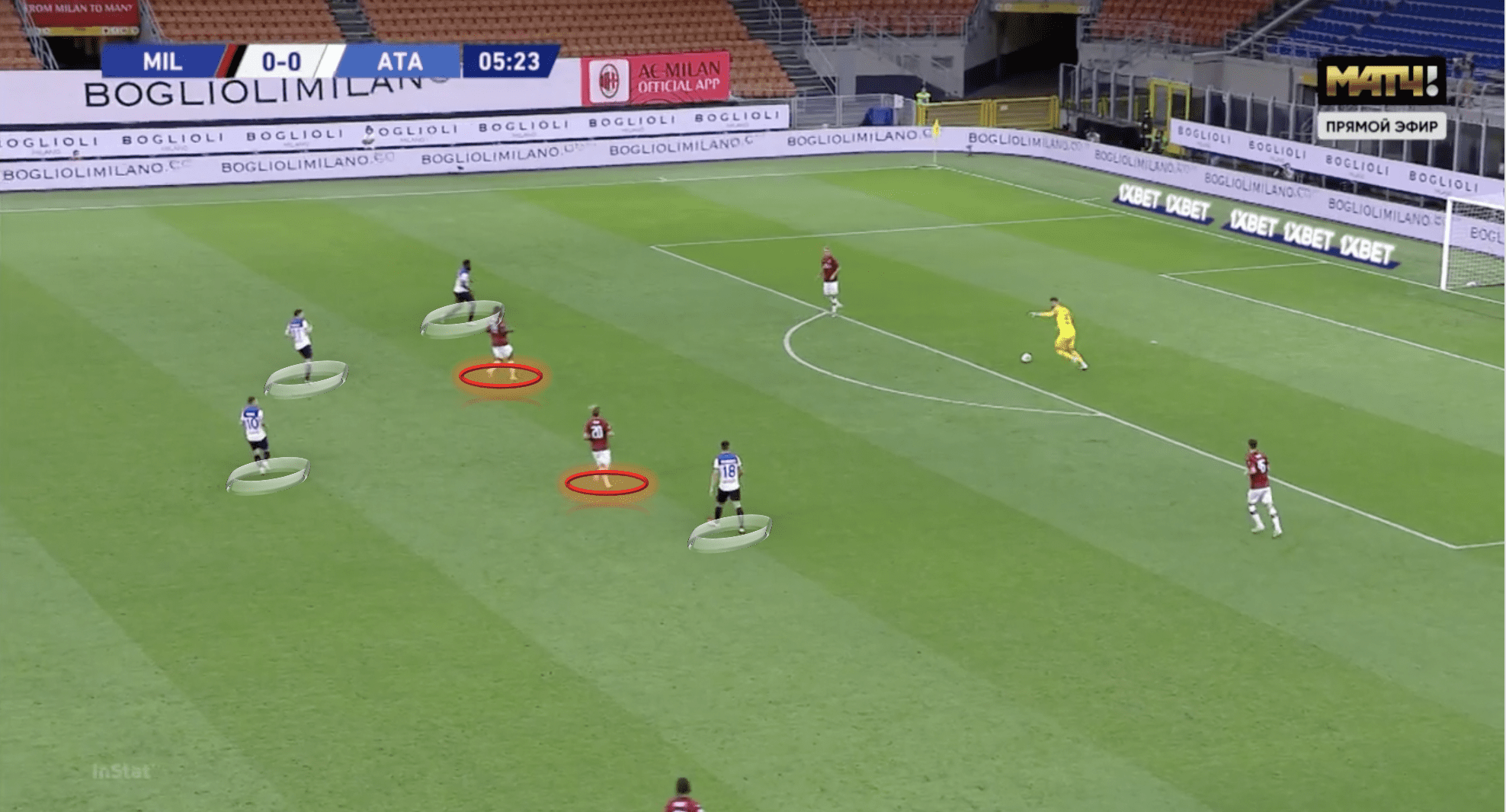
This image shows the same example from Milan. However, this time Atalanta have released another midfield player to join the pressure now and this allows Milan to bypass these plyers as Donnarumma chips into the full-back to create a platform to attack from.
In these moments Atlanta have a decision to make. Do they concede the full-back pass and allow Milan to get out into wide areas and expose their wing-backs? Or do they retreat and use their front three players to help defend in the wide areas?
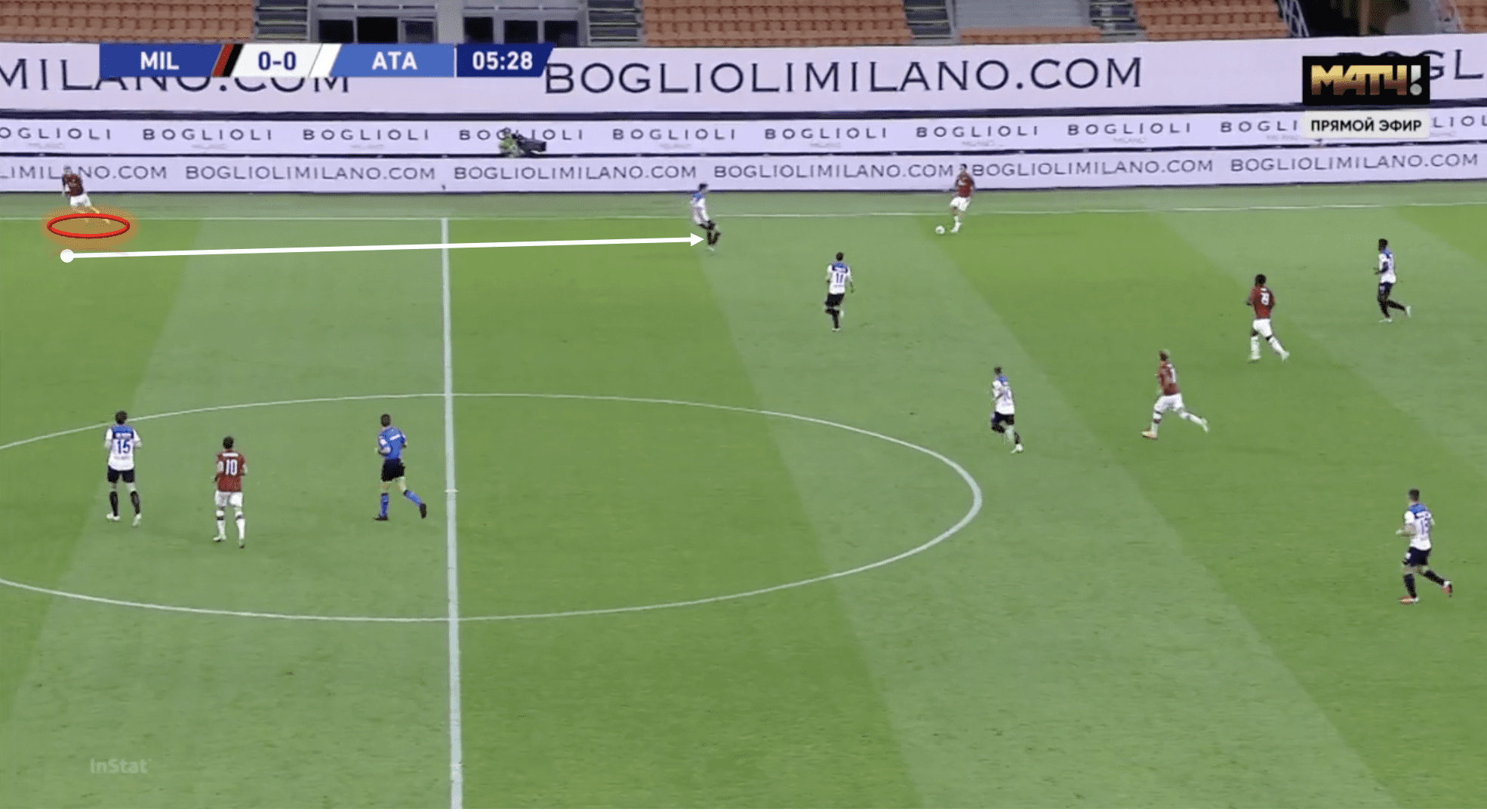
Here, they decide to release the wing-back to the ball which is a good option if he can get close enough to pressure the first touch of the full-back. If not, he runs the risk of being played around and exposing the topline in a potential 1 v 1 situation across the entire line with the Milan #10 joining in too.
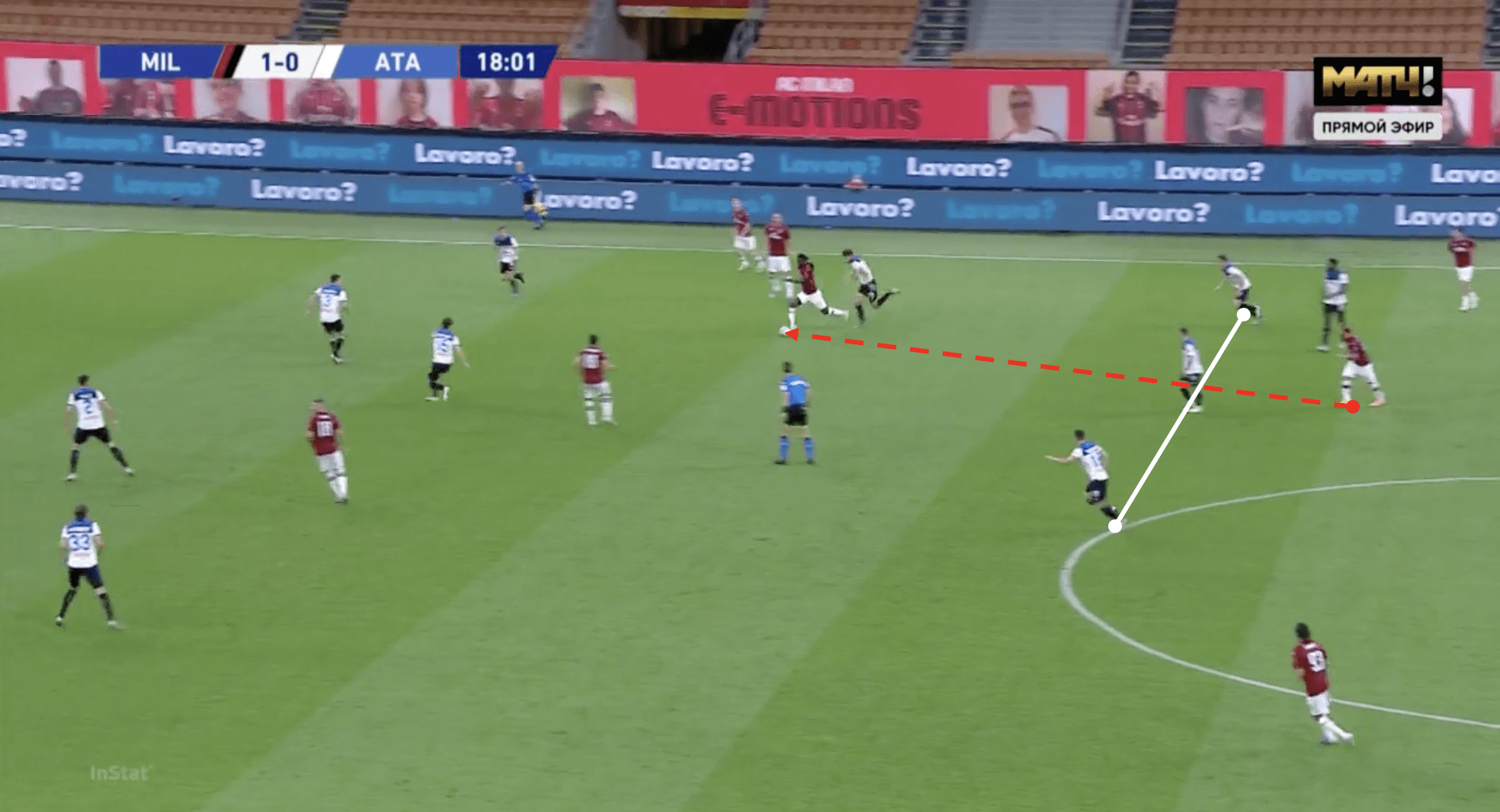
This image gives an insight into the other problems this platform caused Atalanta. From a slightly more advanced position but using the same platform, Milan find Biglia in a central position from the backline who again combines with Kessie to release him into space and driving at the backline of Milan. Notice how narrow Rebic has come on the near side of the top line for Milan to help overload the Atalanta back three and keep the space for the midfield to move into.
This platform with the narrow front three
The next insight to the difficulty Atalanta had in dealing with this attacking plan from Milan can be seen by how narrow their forwards played in order to support Ibrahimović in the top line.
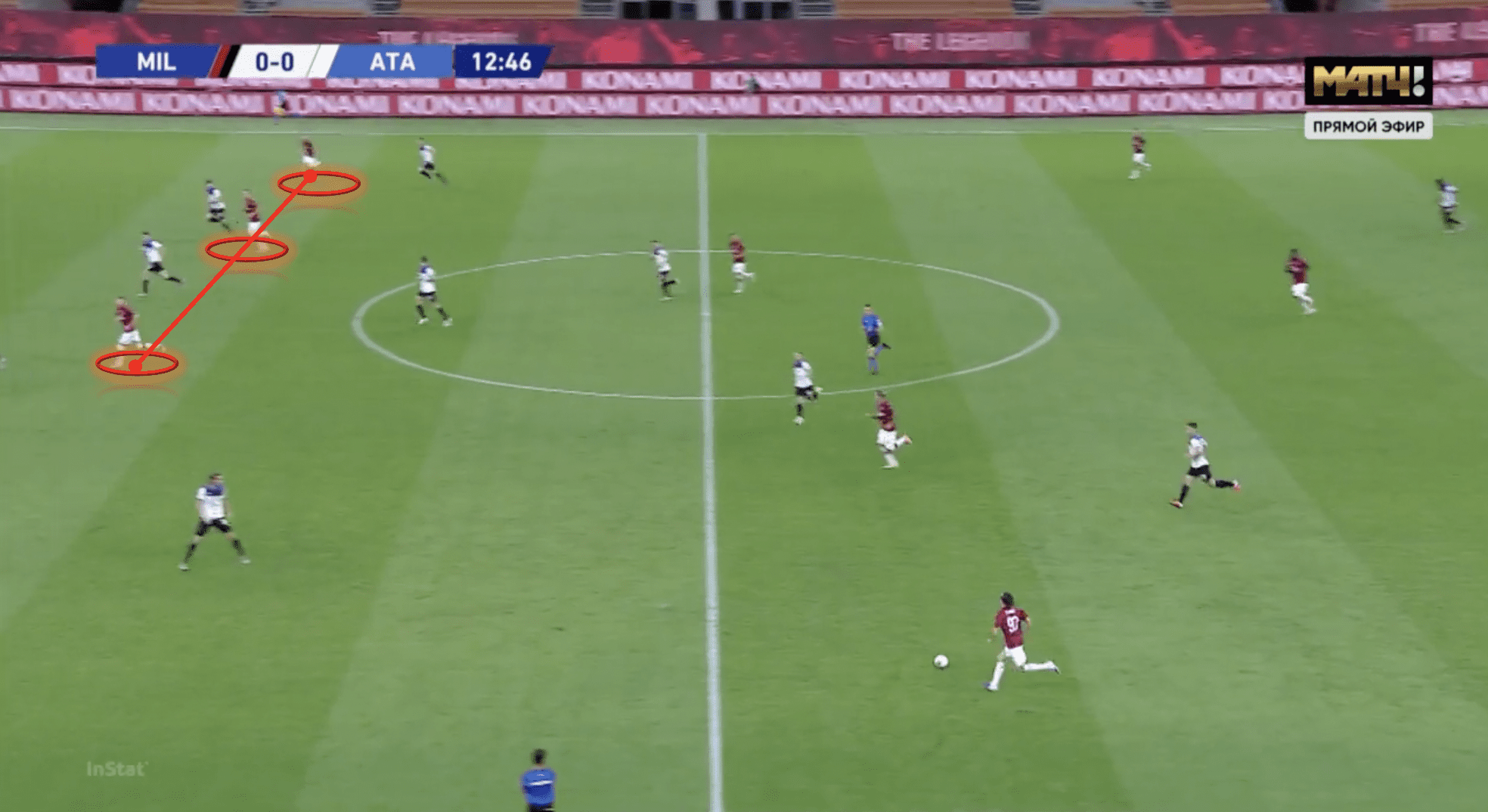
Here in this image, Milan have again played through midfield to release the full-back in time and space to move into. This clearly shows the tough decisions that had to be made. An overload in the top line with the narrow forward line and a wing-back who cannot get pressure on the ball – it’s these moments that Milan should have exploited more, however, chances were limited to longer efforts with only really a trio of clear chances created.
In fairness to Atlanta, they absorbed much of the pressure applied by Milan in these moments. They kept the ball in front of their backline as much as they could and conceded pressing in wide areas to accommodate this. Without Gasperini on the touchline to tweak things defensively, they continued to press forwards when possible, especially from set-pieces like goal kicks and still managed to keep their passes per defensive action (PPDA) down below 5 which is impressive given the way Milan caused them issues.
Atalanta with the ball
You cannot score the goals and create the chances that Atalanta does without having a flexible structure to adapt to the problems the opponent throws at you. In this game, Ibrahimović as a lone frontman allowed Atalanta the chance to release one of the back three into the midfield line to create overloads in wide areas and stretch the Milan midfield across the pitch. This opportunity was created by the two holding midfielders dropping between the back three to almost create a back four with the wide centre-back operating as a full-back.
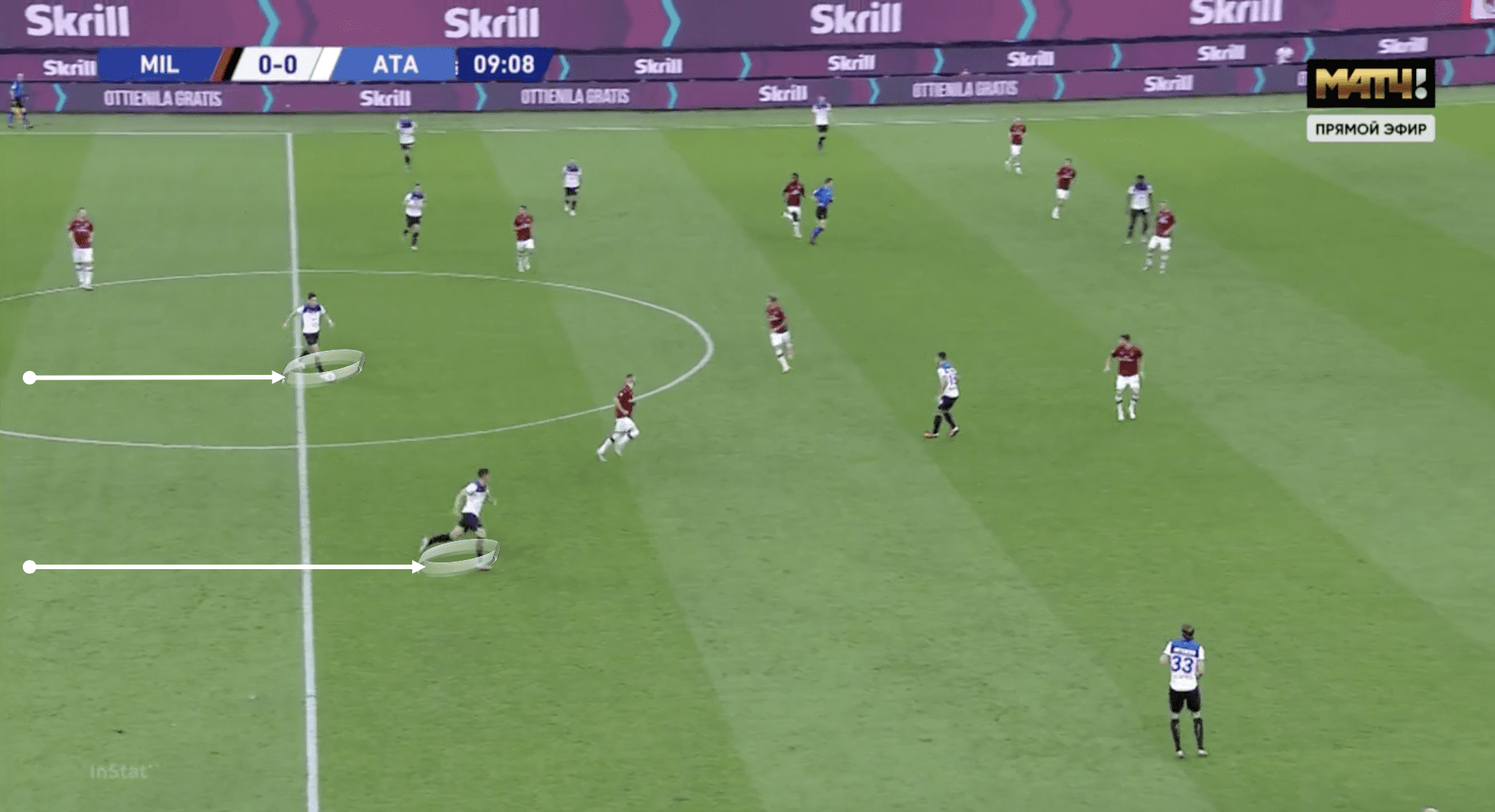
Here you can see de Roon picking the ball up deep and driving into midfield with Toloi the right centre-back running beyond him to double up with Hatebor the wing-back.
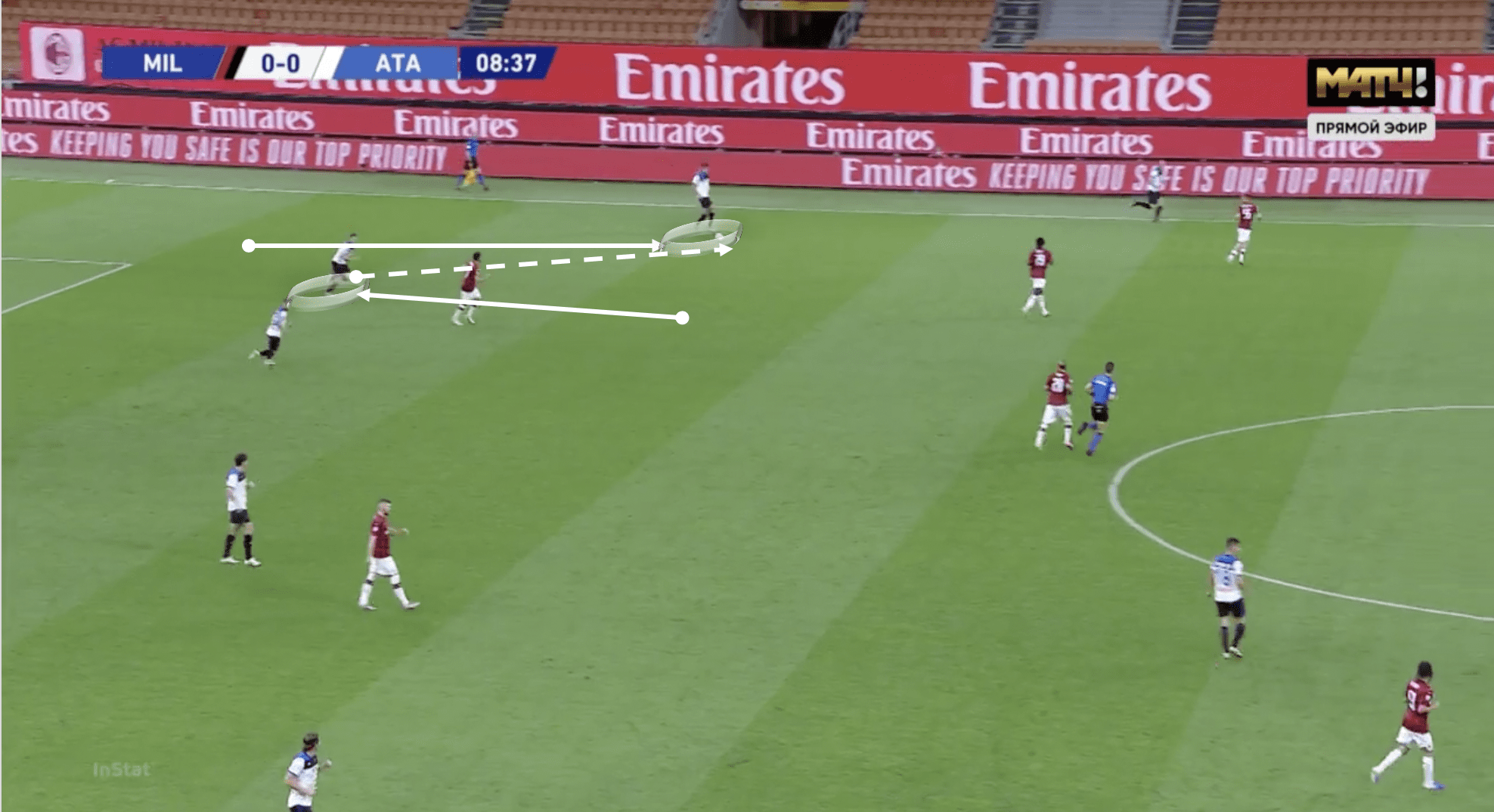
Here, on the other side Fruelar again drops into the backline to release Djimsiti as the full-back to support the wing-back Gosens. This small rotation allowed Atalanta to get the wing-backs higher up the pitch to act more like wingers than defenders. This had a significant knock-on on effect to the way Atalanta was able to attack during the game and why they were dangerous in advanced central positions.
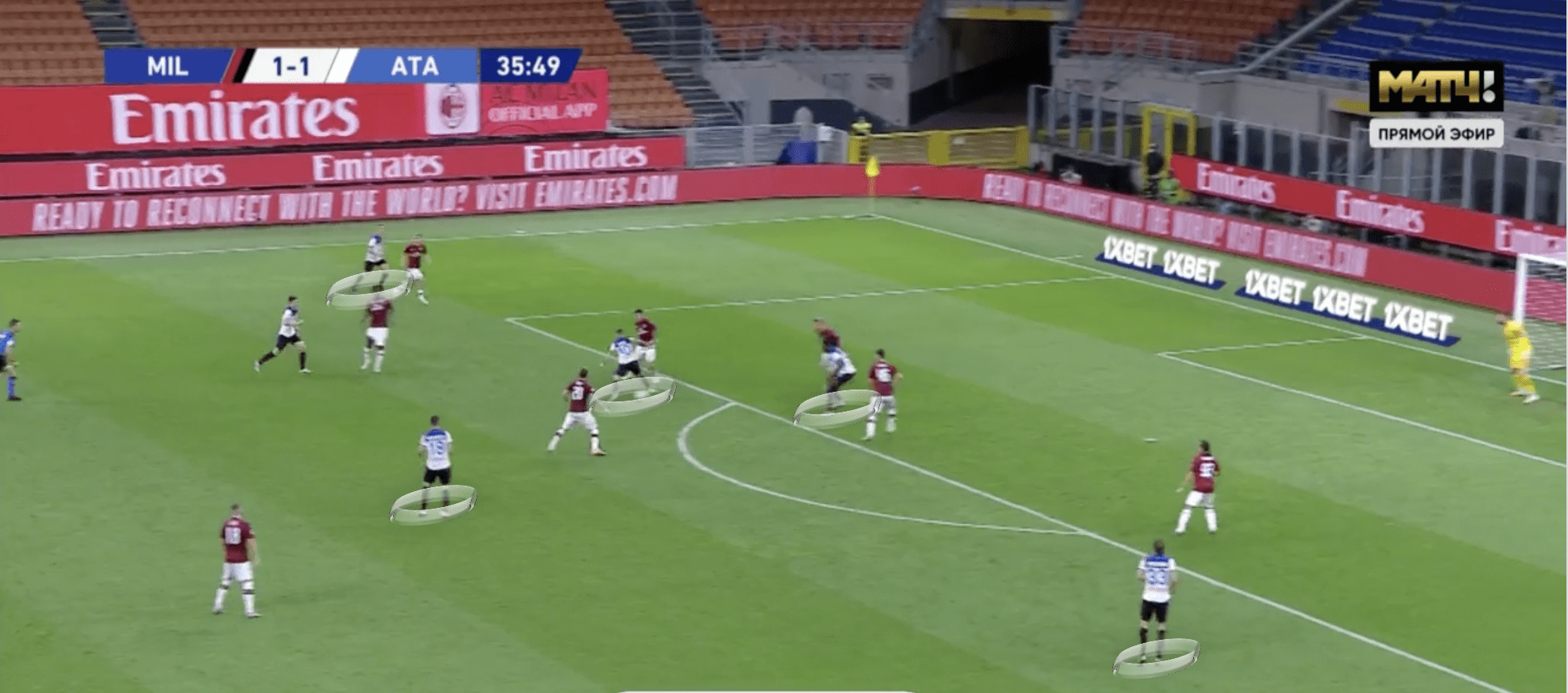
This image shows the value of the Atalanta build-up play to push the wing-backs higher up the pitch. This allowed Gomez and Malinovskyi to operate as a double #10 option for the team with Zapata pining the Milan centre-backs in with his pace and physicality to create a central pivot that the team can always play into like the image above.
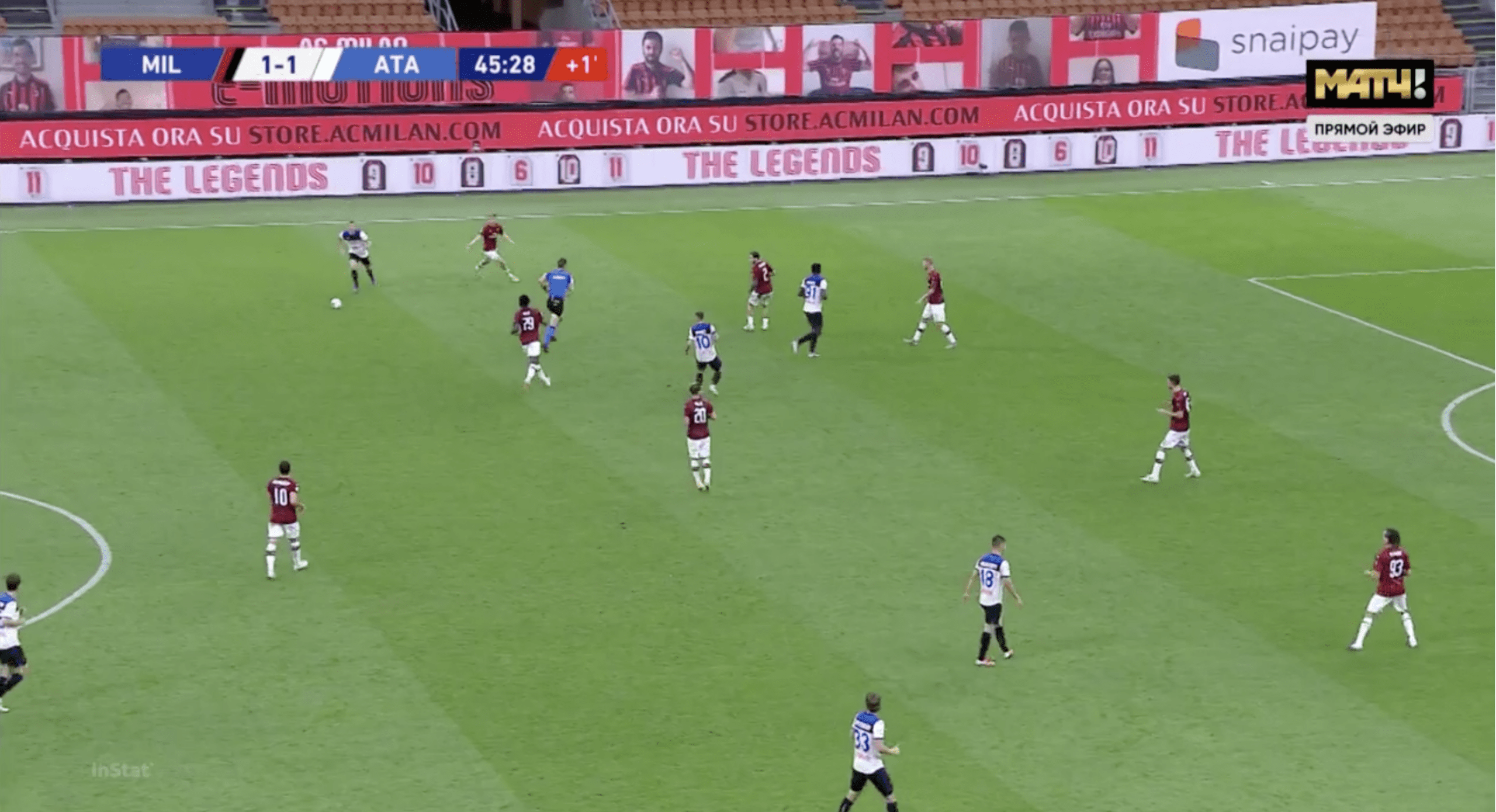
Here again, the same picture. A double #10 platform, with two high wing-backs stretching Milan across the pitch, allowing Atalanta to play incisively into central areas or build around the defensive block into wide areas. When you also include runners coming from deep positions it is easy to see why this team creates so many chances to score goals.
The real positive of this attacking tactic, however, is the connection between Gomez and Zapata. This way of attacking allows them to get closer together to combine and the combination of Zapata’s strength and Gomez’s technical skills is really tough to deal with.
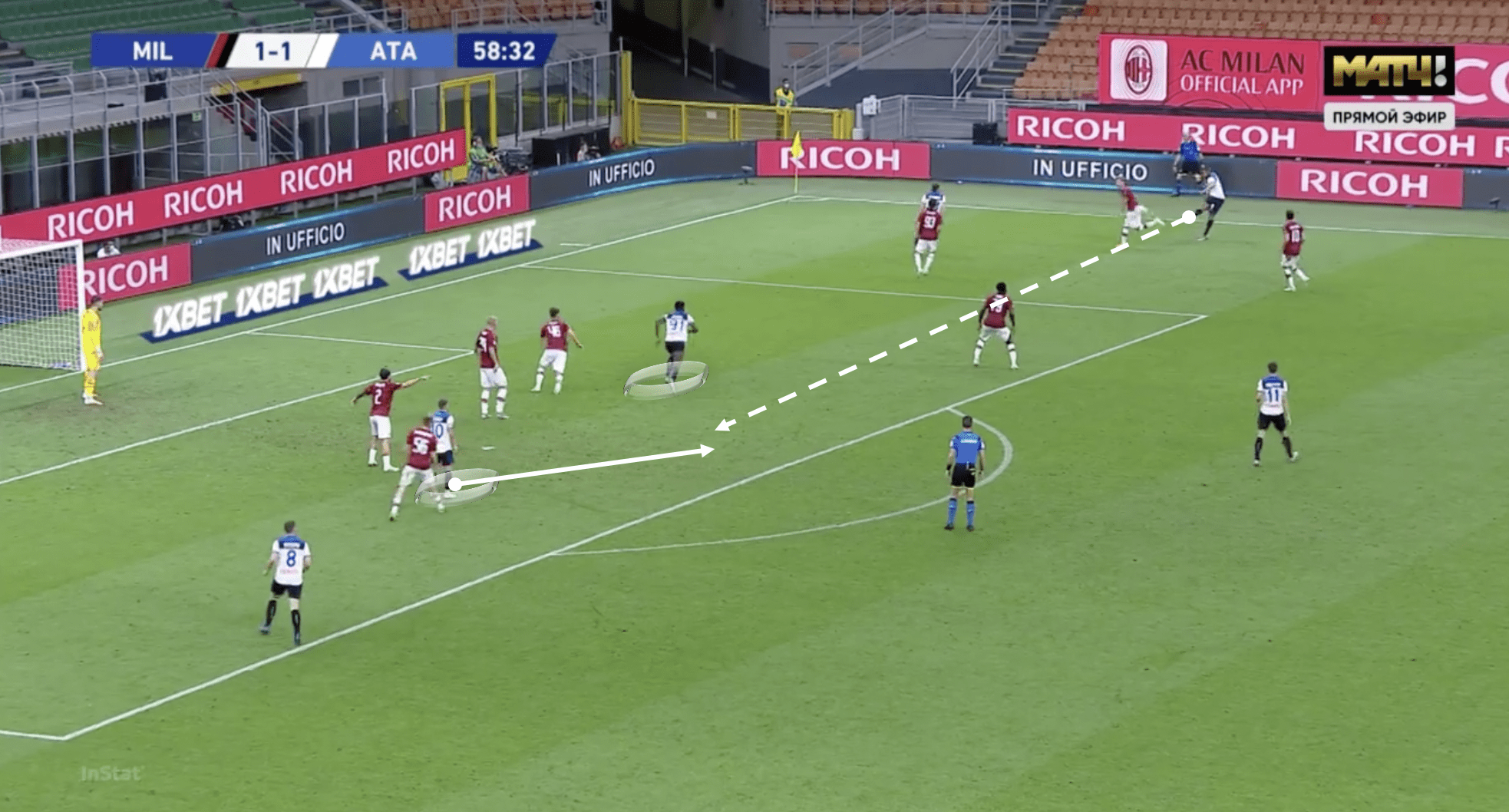
Here is a classic example of this type of combination. Muriel delivers from a wide area with Zapata checking towards the ball to occupy defenders. Gomez spins off the front and into a pocket to receive the pass and hit his half volley narrowly wide of the near post.
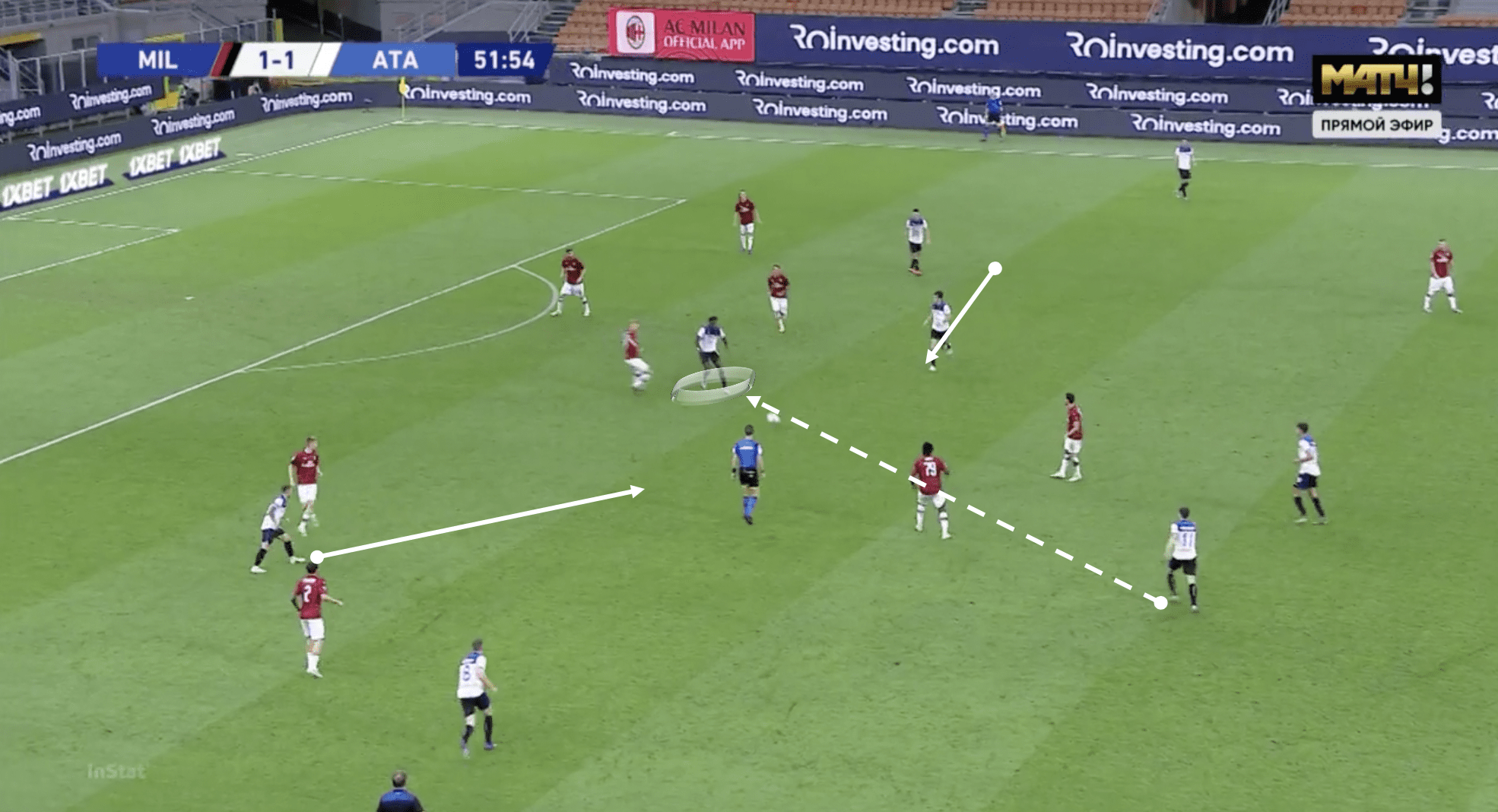
This situation shows the importance of Zapata to the way Gasperini wants his team to attack. His fixed central position is crucial when teams get numbers behind the ball and make it hard to break them down. He allows Atalanta to play into his feet because he is so strong – he can hold the ball and link the rest of the attacking group together. He attracts more than one defender because of this physicality and because of this, can create free men for Atalanta to exploit. With the wing-backs high and trying to get in behind the opposing full-back, they have threats beyond the ball as well as beside or beneath the ball at all times.
Conclusion
The two form teams in Serie A could have produced a game riddled with goals. Instead, they spent most of the game cancelling each other out across the pitch. That doesn’t mean it wasn’t a good quality game with some interesting tactical twists from both managers, but it was a game that lacked a final punch in much of the good stuff created by both sides attacking platforms.
For Milan, we can see more and more of Pioli’s team each time they take the field and he has found a formula that works for his side around the central combination of Ibrahimović and Hakan Çalhanoğlu, who appears to have found his best position in the system with 5 of his 8 goals this season coming after the resumption of Serie A. Even with a slightly makeshift back four, Milan were able to shade possession and find ways through or around Atalanta’s high pressing defensive plan. This is impressive given the impact of Hernandez and Conti on the way Milan attack their opponent but the dominance in this encounter of Kessie especially allowed plenty of time and space in wide areas for Milan to take the sting out of Atalanta’s high pressing actions. They did, however, lack some real punch in the final third and created little of note outside of the free-kick scored by Hakan Çalhanoğlu, and therefore can be happy with the point.
For Atalanta, they will be disappointed they couldn’t turn some dangerous moments in central areas into more meaningful opportunities. For the first time, their substitutes failed to make a significant impact from the bench and despite the endeavours of Zapata and Gomez, they couldn’t create many clear-cut chances as Milan limited them to shots from range. Without Donnarumma’s penalty save, Atalanta likely would have taken all three points and on balance shaded the game so they will be disappointed not to close the gap on Juventus after they left the door ajar with their defeat at Udinese.
Atalanta play again first when they travel to Parma as they look to hold off the charge of Antonio Conte’s Inter side for second place. It’s likely that Gasperini will rotate for rest again, especially if Juventus win in their matchup with Sampdoria the day before. For Milan, they continue to chase Roma and travel to Sampdoria a day later than Atalanta. With a tight turnaround for Sampdoria, it is a game you would expect Milan to win and continue their good work post-restart. Either way, both teams are safe in the knowledge that European football is theirs for next season. Where they end up finishing in the equation is down to them as individuals.





Comments